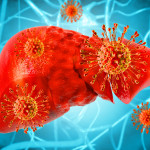Hepatitis C virus (HCV) treatment—when successful—offers survival benefits over and above reductions in liver disease among people coinfected with both HIV and HCV, according to a study reported February 19 at the 17th Conference on Retroviruses and Opportunistic Infections (CROI) in San Francisco.
Researchers have long known that HIV significantly worsens the course of HCV among people infected with both viruses. Moreover, end-stage liver disease, liver failure and liver cancer are some of the top causes of death among people living with HIV, and most of these deaths occur in people who are coinfected.
When to treat HCV in coinfected people is an unresolved question. Some urge earlier treatment—as treatment is more likely to work if someone has less scarring of the liver (fibrosis)—and others suggest waiting for newer treatments to become available for use in combination with older drugs that aren’t highly effective on their own.
When HCV treatment is successful, it greatly reduces the risk of liver disease progression and liver-related deaths. HCV treatment success, called a sustained virological response (SVR), is defined as maintaining undetectable HCV levels for at least six months after completing a course of treatment. What has been less clear, however, is if HCV treatment contributes to the overall survival of people coinfected with both viruses, not just survival tied to liver health.
Juan Berenguer, MD, from the Hospital Universitario Gregorio Marañon in Madrid, and his colleagues set out to answer that question. They analyzed data from the GESIDA 3603 Cohort, which has been following coinfected individuals who received HCV treatment at 20 centers in Spain since January 2000.
In all, Berenguer’s team analyzed data on 1,428 coinfected individuals: 908 of them achieved an SVR, and 520 did not. Just more than half of the study participants were male, and 81 percent had a history of injection drug use. Sixty percent of the participants had the more difficult-to-treat strains of HIV—genotypes 1 or 4—and 30 percent had significant scarring of the liver before treatment was initiated. The average CD4 count just before starting HCV treatment was 584, and 84 percent of people were taking antiretroviral (ARV) therapy.
Berenguer and his colleagues looked at the rate of deaths overall, the rate of liver-related deaths, the rate of AIDS-related deaths and deaths from other causes. They also looked at the development of new AIDS-defining conditions—such as Pneumocystis pneumonia or a drop in CD4 cell count to below 200.
Achieving an SVR had a profound influence on all types of deaths and the progression of HIV disease. Not surprisingly, the rate of liver-related deaths was nine times higher in people who did not achieve an SVR compared with people who did. Of great interest, however, was the finding that the rate of AIDS-related deaths was also more than eight times higher in people who didn’t achieve an SVR.
People were also more likely to experience HIV disease progression if they didn’t achieve an SVR. More than three times as many people who did not have an SVR developed a new AIDS-defining condition, compared with people who did have an SVR.
Berenguer’s team noted that the greatest survival benefits were seen among those starting HCV treatment with low CD4 cell counts. Among those with CD4s below 300, achieving an SVR was significantly more likely to improve overall survival. Among those with CD4s above 300, achieving an SVR mattered less in terms of survival. However, the study may not yet have been following patients long enough to determine whether an SVR affects overall survival in a healthier population of coinfected patients.
Berenguer cautioned against over-interpreting the study results. He pointed out that they were not able to control for active drug use or smoking. Also, there were more people with advanced fibrosis in the non-responders to HCV therapy than in the responders. Advanced fibrosis can blunt the maintenance and recovery of CD4 cell counts, which might in turn affect the rate of progression to AIDS or death.
He concluded that there did appear to be real differences in HIV disease progression if a person achieved an SVR, but that further studies—along with more data from the GESIDA cohort—will be necessary to determine the size of the effect.
Advertisement
Advertisement
Advertisement





Comments
Comments